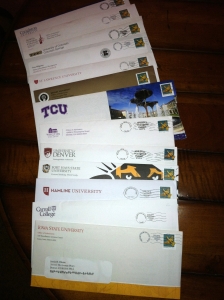 If you’re a junior in high school (and maybe if you’re a freshman or sophomore), chances are that you’ve started receiving mail and email from colleges. You may be wondering how colleges got your name and contact information. If you took the PSAT and/or SAT, you had the option of signing up for the College Board’s Student Search Service; similarly, if you took the PLAN and/or ACT, you were asked if you wanted to register for ACT’s Educational Opportunity Service. Both of these programs provide students’ information to colleges and scholarship organizations, which, in turn, send mail/email to students.
If you’re a junior in high school (and maybe if you’re a freshman or sophomore), chances are that you’ve started receiving mail and email from colleges. You may be wondering how colleges got your name and contact information. If you took the PSAT and/or SAT, you had the option of signing up for the College Board’s Student Search Service; similarly, if you took the PLAN and/or ACT, you were asked if you wanted to register for ACT’s Educational Opportunity Service. Both of these programs provide students’ information to colleges and scholarship organizations, which, in turn, send mail/email to students.
Another way a college might have obtained your information is if you filled out a card at a college fair or when an admissions officer visited your high school. Colleges’ cards ask for such information as your name, address, email address, high school, and graduation year.
Regardless of how colleges got your information, now that they have it, they are going to send you lots and lots of mail and email. The information overload probably will continue into your senior year. The photo at left is of the mail that one of my juniors received over the course of just one week!
Many students feel overwhelmed by the abundance of information they receive from colleges, and they don’t know what to do with it. Perhaps, rather than opening the mail, you’ve been stacking it somewhere in your bedroom. The larger the pile grows, the less inclined you probably are to deal with it. Winter break is a great time to organize all of the information you’ve received, and here are some tips for doing so:
- Tips for mail:
- Open the mail. (This seems obvious, but some people file information without ever looking at it.)
- Throw away (or better yet, recycle) mail from any colleges in which you’re not interested. While I encourage students not to rule out a school simply because they’ve never heard of it, some students have criteria that make particular colleges “deal-breakers”. For example, if you’re certain you want to go to a four-year college, you could toss mail from two-year schools. Or, if you hate the cold, you might have decided to exclude colleges in New England and the Upper Midwest. If you’re not an artist and you get mail from an art school, get rid of it. You get the idea.
- Create a filing system for the colleges that you’re interested in/want to learn more about. You can buy a large file box at a discount store (like Target) or office supply store for a reasonable price. Alternatively, if your parents have a filing cabinet, perhaps they’ll let you use a drawer. Buy hanging file folders and make labels to organize the information. You might want to file it alphabetically by colleges’ names, by the state in which they’re located, or by some other method.
- Add to your existing folders and/or create new folders when you receive more mail. As you research colleges, remove any information from colleges that you’ve eliminated from consideration.
- Tips for email:
- Some students create a separate email address to give to colleges. Whether you’re using a separate address or not, make sure that the email you give colleges is professional. For example, jake.brown@gmail.com and lizsmith98@yahoo.com are okay; jakesoccerstar@gmail.com and cutiepie123@yahoo.com are not.
- Make folders in your inbox and put emails from colleges in those folders. Again, you could create a separate folder for each college, a folder for all colleges in the same state, or folders based on another system that you devise. You also can create filters to automatically move incoming mail from your inbox to your folders.
- As with your paper information, you should go through your email as you research colleges and delete emails from schools that you’ve ruled out.
By following these tips, you can better manage the information you receive from colleges. I think I’ll take my own advice and go sort through the mail from colleges that I’ve been piling on top of my filing cabinet!







[…] Download Image More @ http://www.discoverycollegeconsulting.com […]